Get free scan and check if your device is infected.
Remove it nowTo use full-featured product, you have to purchase a license for Combo Cleaner. Seven days free trial available. Combo Cleaner is owned and operated by RCS LT, the parent company of PCRisk.com.
What is DPD Delivery Email Virus?
"DPD Delivery Email Virus" is one of many spam email campaigns used to proliferate the DanaBot trojan. Users receive a fake notification regarding delivery of a package from the DPD delivery company. They are encouraged to check the delivery status by clicking "Run Parcel Track", however, the link leads to download of an archive containing a malicious .js (JavaScript) file.
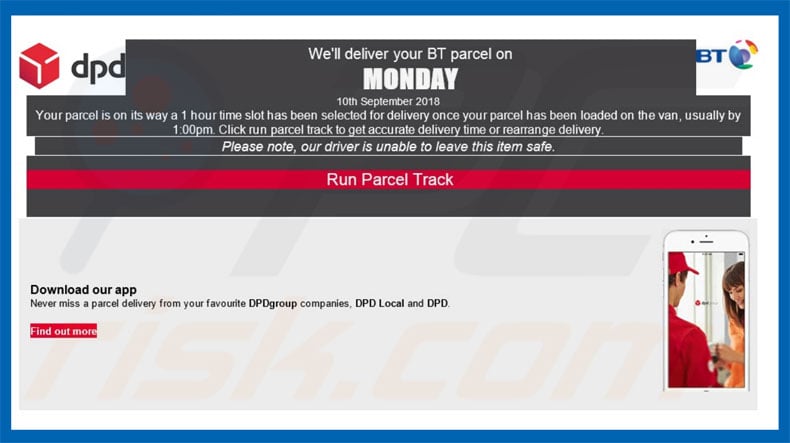
As mentioned above, users are presented with a link that supposedly allows them to track the status of packages. After clicking the link, they are prompted with download of an archived JavaScript file. Opening this file leads to infiltration of the DanaBot trojan. The same email also offers download of a DPDgroup application.
The "Find out more" link also leads to the same JavaScript file download. As mentioned, this email is presented as a notification from DPD - a legitimate delivery company. Clearly, this legitimate organization has nothing to do with the "DPD Delivery Email Virus" spam campaign.
Cyber criminals often hide behind names of popular companies and governmental agencies. They do this to increase the number of infections - users are much more likely to open files when the sender is familiar to them. DanaBot is essentially a banking trojan. Its main purpose is to gather login details and passwords from bank account websites.
DanaBot hijacks browsers and modifies bank websites so that all entered logins/passwords are saved to a remote server controlled by cyber criminals. In addition, DPD Delivery Email Virus takes a screenshot of the victim's desktop, records a list of existing files and detailed system information. This data is also saved to the remote server.
DanaBot's developers aim to generate as much revenue as possible and, thus, it is highly probable that hijacked accounts will be misused through money transfers, online purchases, and so on. The presence of this virus can lead to significant financial loss and serious privacy issues.
Therefore, if you have already opened "DPD Delivery Email Virus" campaign emails, you should immediately delete downloaded files, scan the system with a reputable anti-virus/anti-spyware suite, and eliminate all threats.
| Name | DPD Delivery spam |
| Threat Type | Trojan, Password stealing virus, Banking malware, Spyware |
| Symptoms | Trojans are designed to stealthily infiltrate victim's computer and remain silent thus no particular symptoms are clearly visible on an infected machine. |
| Distribution methods | Infected email attachments, malicious online advertisements, social engineering, software cracks. |
| Damage | Stolen banking information, passwords, identity theft, victim's computer added to a botnet. |
| Malware Removal (Windows) |
To eliminate possible malware infections, scan your computer with legitimate antivirus software. Our security researchers recommend using Combo Cleaner. Download Combo CleanerTo use full-featured product, you have to purchase a license for Combo Cleaner. 7 days free trial available. Combo Cleaner is owned and operated by RCS LT, the parent company of PCRisk.com. |
DanaBot shares many similarities with Hancitor, TrickBot, Emotet, Adwind, and many other trojans distributed using spam campaigns.
Their behavior might slightly differ (some gather personal information, others cause chain infections - one virus distributes another), but all of these viruses pose a direct threat to your privacy and computer safety. Therefore, eliminate them immediately.
How did DPD Delivery Email Virus infect my computer?
"DPD Delivery Email Virus" campaign proliferates a malicious JavaScript file. Once opened, this file executes commands that download and install DanaBot into the system.
Almost all spam email campaigns are based on an identical malware distribution model - cyber criminals present malicious files (in most cases, Microsoft Office documents) as legitimate, thus often tricking users into downloading and opening them.
Note that DanaBot malware works on the Microsoft Windows Operating System only, and users of other platforms have nothing to worry about.
How to avoid installation of malware?
To prevent this situation, be very cautious when browsing the Internet. Think twice before opening email attachments. If the file is not relevant or has been received from a suspicious/unrecognizable email address, it should never be opened.
Furthermore, have a reputable anti-virus/anti-spyware suite installed and running, since these tools can detect and terminate malicious files before they do any damage. Keep installed applications and operating systems up-to-date. The main reasons for computer infections are lack of knowledge and careless behavior, and the key to safety is caution.
If you have already opened a "DPD Delivery Email Virus" attachment, we recommend running a scan with Combo Cleaner Antivirus for Windows to automatically eliminate infiltrated malware.
Text presented in the "DPD Delivery Email Virus" email message:
Subject: Your parcel is on its way
We’ll deliver your BT parcel on
Your parcel is on its way a 1 hour time slot has been selected for delivery once your parcel has been loaded on the van, usually by 1:00pm. Click run parcel track to get accurate delivery time or rearrange delivery.
Please note, our driver is unable to leave this item safe.
Run Parcel Track
Your parcel: -
Download our app
Never miss a parcel delivery from your favourite DPDgroup companies, DPD Local and DPD.
Find out more
Screenshot of DanaBot process in Windows Task Manager:
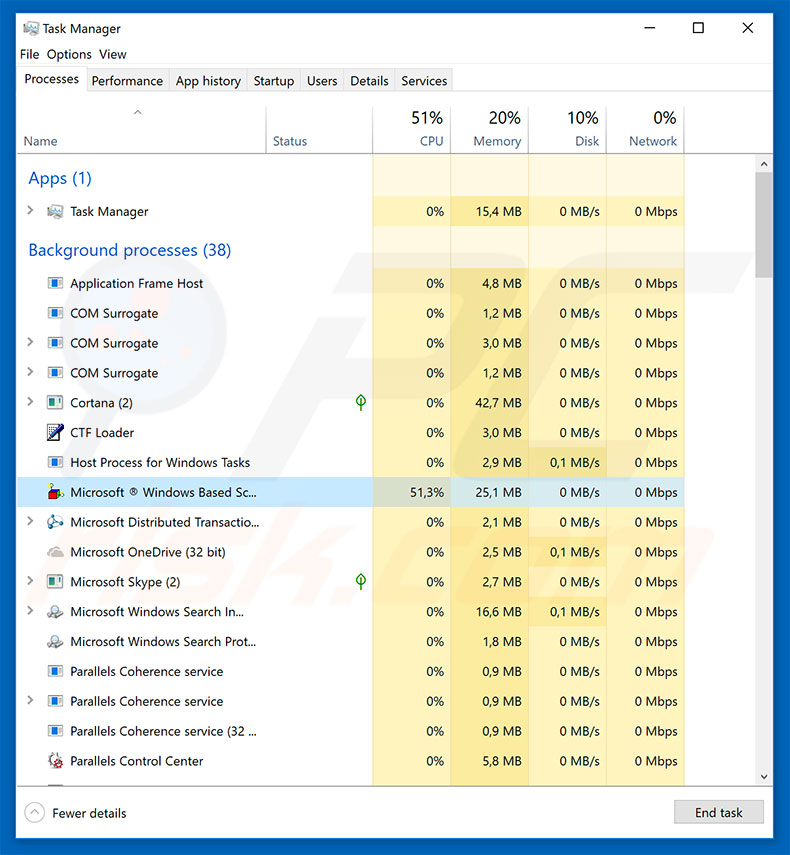
Another variant of "DPD Delivery" email spam campaign (written in Portuguese):
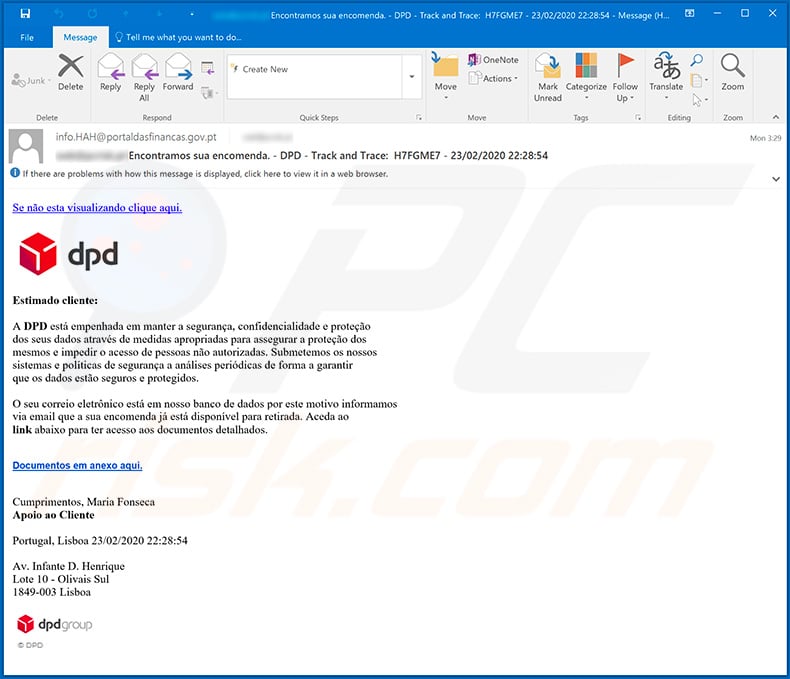
Text presented within this email:
Subject: [Recipient's_Email] Encontramos sua encomenda. - DPD - Track and Trace: H7FGME7 - 23/02/2020 22:28:54
Se não esta visualizando clique aquiz
Estimado cliente:
A DPD está empenhada em manter a segurança, confidencialidade e proteção
dos seus dados através de medidas apropriadas para assegurar a proteção dos
mesmos e impedir o acesso de pessoas não autorizadas. Submetemos os nossos
sistemas e políticas de segurança a análises periódicas de forma a garantir
que os dados estão seguros e protegidos.O seu correio eletrônico está em nosso banco de dados por este motivo informamos
via email que a sua encomenda já está disponível para retirada. Aceda ao
link abaixo para ter acesso aos documentos detalhados.Documentos em anexo aqui.
Cumprimentos, Maria Fonseca
Apoio ao ClientePortugal, Lisboa 23/02/2020 22:28:54
Av. Infante D. Henrique
Lote 10 - Olivais Sul
1849-003 Lisboa
Screenshot of a DPD-themed MS Excel document (distributed via spam emails) which injects Gozi malware into the system:
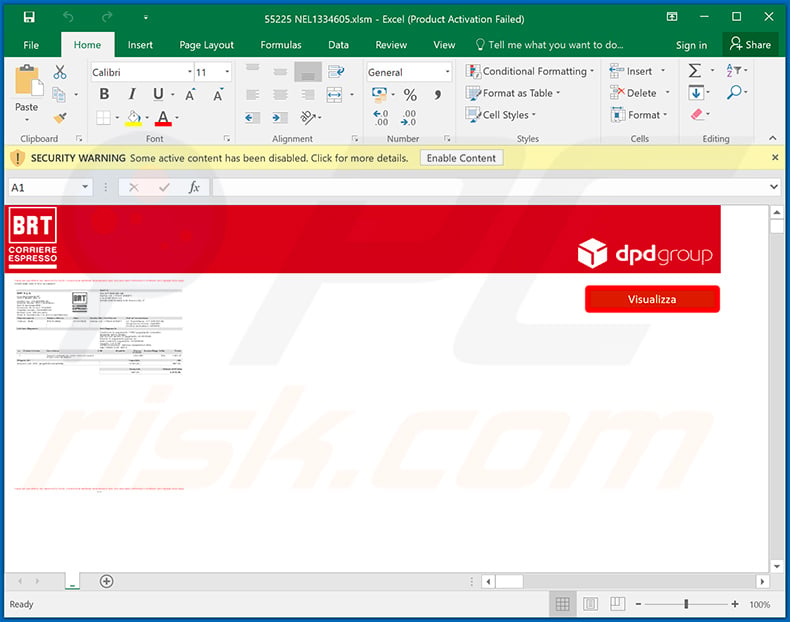
A Lithuanian variant of DPD Delivery-themed spam email spreading malware:
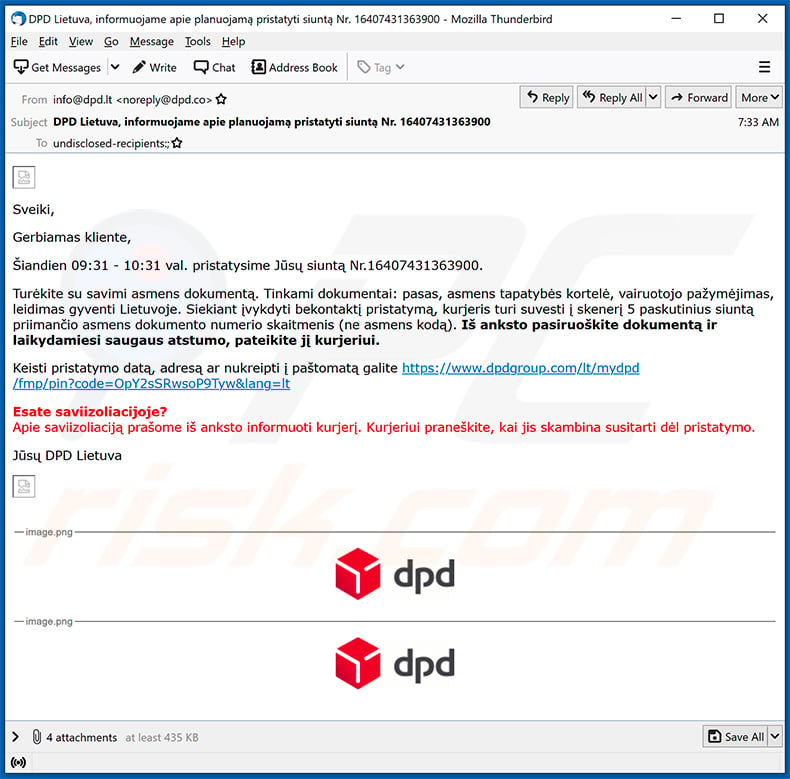
Text presented within:
Subject: DPD Lietuva, informuojame apie planuojamą pristatyti siuntą Nr. 16407431363900
Sveiki,
Gerbiamas kliente,
Šiandien 09:31 - 10:31 val. pristatysime Jūsų siuntą Nr.16407431363900.
Turėkite su savimi asmens dokumentą. Tinkami dokumentai: pasas, asmens tapatybės kortelė, vairuotojo pažymėjimas, leidimas gyventi Lietuvoje. Siekiant įvykdyti bekontaktį pristatymą, kurjeris turi suvesti į skenerį 5 paskutinius siuntą priimančio asmens dokumento numerio skaitmenis (ne asmens kodą). Iš anksto pasiruoškite dokumentą ir laikydamiesi saugaus atstumo, pateikite jį kurjeriui.
Keisti pristatymo datą, adresą ar nukreipti į paštomatą galite hxxps://www.dpdgroup.com/lt/mydpd/fmp/pin?code=OpY2sSRwsoP9Tyw&lang=lt
Esate saviizoliacijoje?
Apie saviizoliaciją prašome iš anksto informuoti kurjerį. Kurjeriui praneškite, kai jis skambina susitarti dėl pristatymo.Jūsų DPD Lietuva
Instant automatic malware removal:
Manual threat removal might be a lengthy and complicated process that requires advanced IT skills. Combo Cleaner is a professional automatic malware removal tool that is recommended to get rid of malware. Download it by clicking the button below:
DOWNLOAD Combo CleanerBy downloading any software listed on this website you agree to our Privacy Policy and Terms of Use. To use full-featured product, you have to purchase a license for Combo Cleaner. 7 days free trial available. Combo Cleaner is owned and operated by RCS LT, the parent company of PCRisk.com.
Quick menu:
- What is DPD Delivery spam?
- Types of malicious emails.
- How to spot a malicious email?
- What to do if you fell for an email scam?
Types of malicious emails:
![]() Phishing Emails
Phishing Emails
Most commonly, cybercriminals use deceptive emails to trick Internet users into giving away their sensitive private information, for example, login information for various online services, email accounts, or online banking information.
Such attacks are called phishing. In a phishing attack, cybercriminals usually send an email message with some popular service logo (for example, Microsoft, DHL, Amazon, Netflix), create urgency (wrong shipping address, expired password, etc.), and place a link which they hope their potential victims will click on.
After clicking the link presented in such email message, victims are redirected to a fake website that looks identical or extremely similar to the original one. Victims are then asked to enter their password, credit card details, or some other information that gets stolen by cybercriminals.
![]() Emails with Malicious Attachments
Emails with Malicious Attachments
Another popular attack vector is email spam with malicious attachments that infect users' computers with malware. Malicious attachments usually carry trojans that are capable of stealing passwords, banking information, and other sensitive information.
In such attacks, cybercriminals' main goal is to trick their potential victims into opening an infected email attachment. To achieve this goal, email messages usually talk about recently received invoices, faxes, or voice messages.
If a potential victim falls for the lure and opens the attachment, their computers get infected, and cybercriminals can collect a lot of sensitive information.
While it's a more complicated method to steal personal information (spam filters and antivirus programs usually detect such attempts), if successful, cybercriminals can get a much wider array of data and can collect information for a long period of time.
![]() Sextortion Emails
Sextortion Emails
This is a type of phishing. In this case, users receive an email claiming that a cybercriminal could access the webcam of the potential victim and has a video recording of one's masturbation.
To get rid of the video, victims are asked to pay a ransom (usually using Bitcoin or another cryptocurrency). Nevertheless, all of these claims are false - users who receive such emails should ignore and delete them.
How to spot a malicious email?
While cyber criminals try to make their lure emails look trustworthy, here are some things that you should look for when trying to spot a phishing email:
- Check the sender's ("from") email address: Hover your mouse over the "from" address and check if it's legitimate. For example, if you received an email from Microsoft, be sure to check if the email address is @microsoft.com and not something suspicious like @m1crosoft.com, @microsfot.com, @account-security-noreply.com, etc.
- Check for generic greetings: If the greeting in the email is "Dear user", "Dear @youremail.com", "Dear valued customer", this should raise suspiciousness. Most commonly, companies call you by your name. Lack of this information could signal a phishing attempt.
- Check the links in the email: Hover your mouse over the link presented in the email, if the link that appears seems suspicious, don't click it. For example, if you received an email from Microsoft and the link in the email shows that it will go to firebasestorage.googleapis.com/v0... you shouldn't trust it. It's best not to click any links in the emails but to visit the company website that sent you the email in the first place.
- Don't blindly trust email attachments: Most commonly, legitimate companies will ask you to log in to their website and to view any documents there; if you received an email with an attachment, it's a good idea to scan it with an antivirus application. Infected email attachments are a common attack vector used by cybercriminals.
To minimise the risk of opening phishing and malicious emails we recommend using Combo Cleaner Antivirus for Windows.
Example of a spam email:

What to do if you fell for an email scam?
- If you clicked on a link in a phishing email and entered your password - be sure to change your password as soon as possible. Usually, cybercriminals collect stolen credentials and then sell them to other groups that use them for malicious purposes. If you change your password in a timely manner, there's a chance that criminals won't have enough time to do any damage.
- If you entered your credit card information - contact your bank as soon as possible and explain the situation. There's a good chance that you will need to cancel your compromised credit card and get a new one.
- If you see any signs of identity theft - you should immediately contact the Federal Trade Commission. This institution will collect information about your situation and create a personal recovery plan.
- If you opened a malicious attachment - your computer is probably infected, you should scan it with a reputable antivirus application. For this purpose, we recommend using Combo Cleaner Antivirus for Windows.
- Help other Internet users - report phishing emails to Anti-Phishing Working Group, FBI’s Internet Crime Complaint Center, National Fraud Information Center and U.S. Department of Justice.
Share:

Tomas Meskauskas
Expert security researcher, professional malware analyst
I am passionate about computer security and technology. I have an experience of over 10 years working in various companies related to computer technical issue solving and Internet security. I have been working as an author and editor for pcrisk.com since 2010. Follow me on Twitter and LinkedIn to stay informed about the latest online security threats.
PCrisk security portal is brought by a company RCS LT.
Joined forces of security researchers help educate computer users about the latest online security threats. More information about the company RCS LT.
Our malware removal guides are free. However, if you want to support us you can send us a donation.
DonatePCrisk security portal is brought by a company RCS LT.
Joined forces of security researchers help educate computer users about the latest online security threats. More information about the company RCS LT.
Our malware removal guides are free. However, if you want to support us you can send us a donation.
Donate
▼ Show Discussion